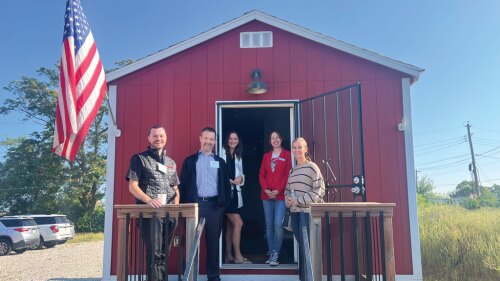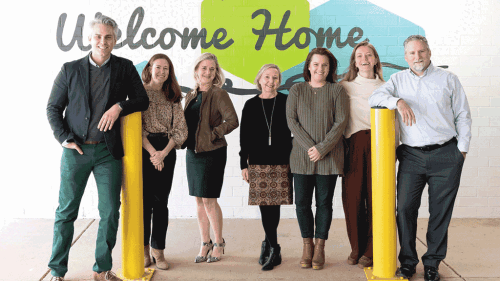Since the first dot-com era, technology firms have rewritten the rules of workplace design, eschewing traditional office towers in favor of renovated warehouses and shrinking individual desk space to make room for more collaborative areas. Today’s tech companies increasingly internalize the mix of uses found in cities, incorporating elements as varied as cafés and vegetable gardens. Design inspiration may come from a building’s historic elements, a company’s founding stories, and the interests of the workers themselves, lending the workplace a feeling of authenticity and personalization.
The following ten projects—all completed during the past three years—include adapted textile factory buildings and liquor distribution warehouses, workplaces with amphitheaters and secret rooms, and a net-zero-energy structure.
Ron Nyren is a freelance architecture, urban design, and real estate writer based in the San Francisco Bay area.
1. Airbnb
San Francisco, California
Founded in 2008, Airbnb enables travelers to book spaces in individuals’ homes via its website. So when the fast-growing company decided to relocate its San Francisco headquarters to the top two floors of the historic Eveready Battery Company warehouse, it wanted spaces to reflect the rooms its users rent out across the globe. The local office of architecture firm Gensler had renovated the building, which offers an outdoor courtyard, skylights, and a five-story atrium with a three-story living wall.
Gensler also designed the interiors for Airbnb. The open office floor plan includes eight collaboration spaces designed by local Interior Design Fair to replicate actual rooms from Airbnb’s listings in places like Milan, Bali, and Paris. Some of the floors, wall panels, and furniture were donated by the Rhode Island School of Design, the alma mater of two of the firm’s founders. Completed in 2013, the office also has a circular boardroom, a library for focused work, a full-service kitchen, and a dining area with views of the city’s skyline.
2. Google
Dublin, Ireland
In the heart of Dublin’s Docklands district, internet search provider Google purchased four existing buildings, two of which it was already occupying, and had them renovated for its European Union headquarters. Dubbed the “Google Docks,” the 14-story tower is the city’s tallest commercial building. Each of its floors has its own identity, developed based on employees’ input, including one called “Be Green” that reflects the company’s ecological focus. Each floor contains open-plan and flexible working spaces. In the ground-floor lobby, large sculptural elements shelter work pods and spell out the company’s multicolored logo, visible from the street.
Of the other three buildings, one incorporates the colors of international flags in a nod to the company’s multicultural workforce; one references Irish culture and houses a replica of a pub and a library space modeled on Trinity College’s library; and one draws inspiration from natural and manmade landscapes. Designed by Zurich-based Evolution Design with local firm Henry J. Lyons Architects and completed in 2013, the campus includes informal meeting rooms, small kitchens, game areas, cafés, a gymnasium, and an indoor swimming pool.
3. Kickstarter
Brooklyn, New York
Two of the founders of Kickstarter, an online crowdfunding platform, met in a Brooklyn diner in 2005: one was a waiter, the other a regular customer. In the company’s Brooklyn headquarters, completed in 2014, a seating area is furnished with diner banquettes to recall that encounter. Kickstarter brought in New York City–based Ole Sondresen Architect to transform the historic Eberhard Faber Pencil Company factory into a workspace for 120 employees. Sondresen preserved historic elements, including lintels and arches, and repurposed the factory’s steel roof trusses to frame windows surrounding a new internal courtyard.
The building has open-plan offices, conference rooms, a gallery, a cafeteria, and indoor bicycle parking. A 74-seat theater allows the company to host guest lectures, performances, and film screenings. On the roof, a garden tended by the employees supplies vegetables, fruits, and herbs.
4. LinkedIn
Toronto, Ontario, Canada
Business-oriented social networking service LinkedIn leased space on the 25th and 26th floors of Eaton Centre in downtown Toronto for its Canadian headquarters. Before beginning design, the local office of IA Interior Architects surveyed LinkedIn employees to get a sense of their work needs and personal interests. In response to their passions for exploring the great outdoors and the city, the design team supplied numerous references to Canada’s natural and civic landscape.
The elevator lobby has one wall with a birch tree pattern in the blue of the company’s logo. The wall behind the reception desk bears a topographical relief map of Canada. The café includes four colorful structures that reference the shape of the city’s rowhouses and shelter meeting areas. Another meeting area consists of picnic tables with a fireplace. Curving, sound-absorbing partitions, covered with green felt cut into leaf shapes, separate the game area from meeting space. The offices were completed in 2014.
5. Pandora
New York, New York
Internet radio service Pandora’s office on the 19th and 20th floors of a 1920s-era office building in midtown Manhattan expresses the centrality of music to the company’s business in a number of ways, from an amphitheater-style gathering space, which can hold up to 65 people for concerts or meetings, to a wall made of vertical wood slats milled to create abstract depictions of well-known musical artists from various genres and eras.
Local firm ABA Studio/Andrew Bartle Architects connected the two floors with a double-height space that includes a wide staircase equipped with seating platforms for informal meetings. Open desk areas occupy the north and south ends of the building, punctuated with freestanding, irregularly shaped meeting rooms of different sizes, which are enclosed in colored glass patterned with dots to provide a degree of privacy. The space was completed in 2014.
6. Shipwire
Sunnyvale, California
Silicon Valley is dotted with nondescript, single-story concrete tilt-up buildings dating back to the 1970s. Sharp Development of Portola Valley, California, decided to transform one in Sunnyvale into a net-zero-energy facility to appeal to tech companies. The San Jose office of RMW Architecture and Interiors retrofitted the structure with rooftop photovoltaic panels, 43 custom skylights, and a high-efficiency building envelope. Skylights and windows open automatically at night to flush air out of the building for cooling. Electrochromic glass transitions from clear to opaque depending on the angle of sunlight, mitigating heat gain and cutting glare.
Building tenant Shipwire, an enterprise shipping logistics company, also brought in RMW for an interior buildout that would take maximal advantage of the sustainable aspects. Placing benched workstations along the glazed perimeter allows natural light to penetrate deep into the space; meeting rooms are enclosed in glass. Completed in 2014, the building also includes a back patio with a bocce court and raised-bed vegetable gardens.
7. Tencent
Guangzhou, China
For its new Guangzhou office, the Chinese internet service provider Tencent chose six run-down factory buildings scattered across a larger industrial site undergoing redevelopment. To link the structures and create a sense of a campus, the designers—the local office of M Moser Associates—connected four of the buildings with open-sided bridges made of wood and steel. The designers preserved the factory buildings’ red brick facades and industrial character, but brought in references to the natural world: In the main entrance foyer’s full-height glass atrium, curving white fins on the ceiling represent clouds, and work and meeting spaces are stacked irregularly to resemble a cliff face.
Four of the buildings contain workspaces. The remaining two contain meeting rooms, a cafeteria, and other amenities. The large floor plates on the interiors were left open, with aisles and vegetated walls added to shape circulation and separate areas with different functions. By inserting mezzanine floors, the designers increased square footage while retaining the open feeling of the high-ceilinged spaces. The project was completed in 2014.
8. Weebly
San Francisco, California
The brick-and-timber edifice at 460 Bryant Street in San Francisco’s South of Market area was constructed in 1907 as a liquor distribution warehouse. After Prohibition, it housed various businesses, ranging from a furniture company to a type foundry. More recently, as a vacant building, it hosted late-night raves. In 2013, local real estate company Sierra Maestra Properties purchased it and renovated it into office spaces. Web-hosting/website-building service Weebly quickly signed a lease.
The local office of Huntsman bisected the ground floor with a long entry ramp, placing the reception area, lobby, boardroom, and interview rooms on the east side and workspaces on the west. The basement houses a dining area with long picnic benches, a fitness center, a cocktail bar, and a DJ booth. Traces of the past remain: graffiti from the rave days can be found in the fitness center, and Huntsman added a “speakeasy” room that recalls the Prohibition era, with period furniture and flocked velvet wallpaper. To enter the room’s secret door—a pivoting bookcase—visitors must pull out the correct volume from the shelf. The project was completed in 2015.
9. Yelp
New York, New York
In 2014, online rating service Yelp leased two floors at 11 Madison Avenue to accommodate the rapid growth of its Manhattan workforce. Most of the company’s staff members are in sales—employees strike a gong when they reach a sales target—so keeping the energy high was critical, especially given the large floor plates.
Local firm Design Republic Partners Architects broke the large floor plates into neighborhoods and took design cues from New York City itself to demarcate spaces and lend coherence to them. Subway lines, color-stained into the concrete floor, lead to each neighborhood, with legends placed throughout to further help with wayfinding. A coffee shop, a night-bazaar-themed café, a lounge patterned after the High Line, and a gaming area with subway-inspired seating break up the workspaces, reminding employees of the role the company plays in guiding customers through the city’s landscape of businesses and attractions. The project was completed in 2015.
10. Zendesk
San Francisco, California
Founded in Denmark, Zendesk provides customer service support software. Having moved to San Francisco in 2009, the company kept expanding, and in 2013 chose the recently renovated Eastern Outfitting Company in the city’s Mid-Market neighborhood for its headquarters. Built in 1909, the seven-story building had been renovated recently and its Corinthian columns and white sandstone facade restored. In keeping with the company’s core tenets—Airy, Humble, Charming, Uncomplicated—local firm Design Blitz took a minimalist approach, retaining original rafters, beams, concrete floors, and brick walls.
Openings cut in the ground floor connect it to the basement. A wide staircase leads down, with stadium seating on its steps to provide places for casual interaction. A living moss wall also links the two spaces: green is the only bright color in the otherwise neutral palette throughout. Through a community benefits agreement with the city, Zendesk makes meeting space available to local nonprofit groups and other local organizations to help regenerate this once-downtrodden part of the city.















